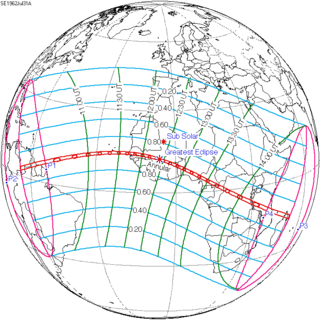| Solar eclipse of July 31, 1962 | |
|---|---|
| Type of eclipse | |
| Nature | Annular |
| Gamma | −0.113 |
| Magnitude | 0.9716 |
| Maximum eclipse | |
| Duration | 213 s (3 min 33 s) |
| Coordinates | 12°00′N 5°42′W / 12°N 5.7°W |
| Max. width of band | 103 km (64 mi) |
| Times ( UTC) | |
| Greatest eclipse | 12:25:33 |
| References | |
| Saros | 135 (36 of 71) |
| Catalog # (SE5000) | 9425 |
An annular solar eclipse occurred at the Moon's ascending node of orbit on Tuesday, July 31, 1962, with a magnitude of 0.9716. A solar eclipse occurs when the Moon passes between Earth and the Sun, thereby totally or partly obscuring the image of the Sun for a viewer on Earth. An annular solar eclipse occurs when the Moon's apparent diameter is smaller than the Sun's, blocking most of the Sun's light and causing the Sun to look like an annulus (ring). An annular eclipse appears as a partial eclipse over a region of the Earth thousands of kilometres wide. Occurring only 4.7 days before apogee (on August 5, 1962), the Moon's apparent diameter was larger. This solar eclipse occurred 44 days after the final game of 1962 FIFA World Cup.
Places inside the annular eclipse included Venezuela, northern Roraima in Brazil, Guyana, Dutch Guiana (today's Suriname) including the capital city Paramaribo, Senegal, Gambia Colony and Protectorate (today's Gambia) including the southern part of the capital city Banjul, Mali including the capital city Bamako, Upper Volta (today's Burkina Faso), Ghana, Togo, Dahomey (today's Benin), Nigeria, Cameroon including the capital city Yaoundé, Congo-Brazzaville, Congo-Léopoldville (today's DR Congo), Tanganyika (now belonging to Tanzania), northeastern tip of Portuguese Mozambique (today's Mozambique), French Comoros (today's Comoros), Mayotte, and the Malagasy Republic (today's Madagascar). The greatest eclipse was in the area of Kouoro, Mali at 12 N, 5.7 W at 12:25 (UTC) and lasted for 3 minutes. [1]
- A total solar eclipse on February 5, 1962.
- A penumbral lunar eclipse on February 19, 1962.
- A penumbral lunar eclipse on July 17, 1962.
- An annular solar eclipse on July 31, 1962.
- A penumbral lunar eclipse on August 15, 1962.
- Preceded by: Solar eclipse of October 12, 1958
- Followed by: Solar eclipse of May 20, 1966
- Preceded by: Solar eclipse of June 20, 1955
- Followed by: Solar eclipse of September 11, 1969
- Preceded by: Lunar eclipse of July 26, 1953
- Followed by: Lunar eclipse of August 6, 1971
- Preceded by: Solar eclipse of September 1, 1951
- Followed by: Solar eclipse of June 30, 1973
- Preceded by: Solar eclipse of July 20, 1944
- Followed by: Solar eclipse of August 10, 1980
- Preceded by: Solar eclipse of August 21, 1933
- Followed by: Solar eclipse of July 11, 1991
- Preceded by: Solar eclipse of September 29, 1875
- Followed by: Solar eclipse of May 31, 2049
This eclipse is a member of a semester series. An eclipse in a semester series of solar eclipses repeats approximately every 177 days and 4 hours (a semester) at alternating nodes of the Moon's orbit. [2]
The partial solar eclipses on June 10, 1964 and December 4, 1964 occur in the next lunar year eclipse set.
| Solar eclipse series sets from 1961 to 1964 | ||||||
|---|---|---|---|---|---|---|
| Descending node | Ascending node | |||||
| Saros | Map | Gamma | Saros | Map | Gamma | |
120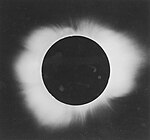
|
February 15, 1961 Total |
0.883 | 125 |
August 11, 1961 Annular |
−0.8859 | |
| 130 |
February 5, 1962 Total |
0.2107 | 135 |
July 31, 1962 Annular |
−0.113 | |
| 140 |
January 25, 1963 Annular |
−0.4898 | 145 |
July 20, 1963 Total |
0.6571 | |
| 150 |
January 14, 1964 Partial |
−1.2354 | 155 |
July 9, 1964 Partial |
1.3623 | |
This eclipse is a part of Saros series 135, repeating every 18 years, 11 days, and containing 71 events. The series started with a partial solar eclipse on July 5, 1331. It contains annular eclipses from October 21, 1511 through February 24, 2305; hybrid eclipses on March 8, 2323 and March 18, 2341; and total eclipses from March 29, 2359 through May 22, 2449. The series ends at member 71 as a partial eclipse on August 17, 2593. Its eclipses are tabulated in three columns; every third eclipse in the same column is one exeligmos apart, so they all cast shadows over approximately the same parts of the Earth.
The longest duration of annularity was produced by member 16 at 10 minutes, 41 seconds on December 24, 1601, and the longest duration of totality will be produced by member 62 at 2 minutes, 27 seconds on May 12, 2431. All eclipses in this series occur at the Moon’s ascending node of orbit. [3]
| Series members 28–49 occur between 1801 and 2200: | ||
|---|---|---|
| 28 | 29 | 30 |
 May 5, 1818 |
 May 15, 1836 |
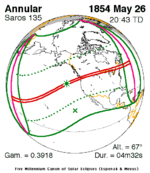 May 26, 1854 |
| 31 | 32 | 33 |
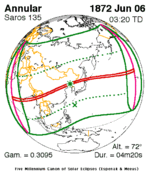 June 6, 1872 |
 June 17, 1890 |
 June 28, 1908 |
| 34 | 35 | 36 |
 July 9, 1926 |
 July 20, 1944 |
 July 31, 1962 |
| 37 | 38 | 39 |
 August 10, 1980 |
 August 22, 1998 |
 September 1, 2016 |
| 40 | 42 | 42 |
 September 12, 2034 |
 September 22, 2052 |
 October 4, 2070 |
| 43 | 44 | 45 |
 October 14, 2088 |
 October 26, 2106 |
 November 6, 2124 |
| 46 | 47 | 48 |
 November 17, 2142 |
 November 27, 2160 |
 December 9, 2178 |
| 49 | ||
 December 19, 2196 | ||
This eclipse is a part of the long period inex cycle, repeating at alternating nodes, every 358 synodic months (≈ 10,571.95 days, or 29 years minus 20 days). Their appearance and longitude are irregular due to a lack of synchronization with the anomalistic month (period of perigee). However, groupings of 3 inex cycles (≈ 87 years minus 2 months) comes close (≈ 1,151.02 anomalistic months), so eclipses are similar in these groupings. In the 18th century:
- Solar Saros 127: Total Solar Eclipse of 1731 Jan 08
- Solar Saros 128: Annular Solar Eclipse of 1759 Dec 19
- Solar Saros 129: Annular Solar Eclipse of 1788 Nov 27
| Inex series members between 1801 and 2200: | ||
|---|---|---|
| Near lunar perigee | After lunar apogee Before lunar perigee |
Before lunar apogee After lunar perigee |
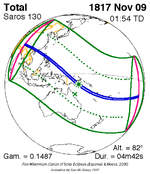 November 9, 1817 (Saros 130) |
 October 20, 1846 (Saros 131) |
 September 29, 1875 (Saros 132) |
 September 9, 1904 (Saros 133) |
 August 21, 1933 (Saros 134) |
 July 31, 1962 (Saros 135) |
 July 11, 1991 (Saros 136) |
 June 21, 2020 (Saros 137) |
 May 31, 2049 (Saros 138) |
 May 11, 2078 (Saros 139) |
 April 23, 2107 (Saros 140) |
 April 1, 2136 (Saros 141) |
 March 12, 2165 (Saros 142) |
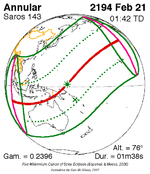 February 21, 2194 (Saros 143) |
|
In the 23rd century:
- Solar Saros 144: Annular Solar Eclipse of 2223 Feb 01
- Solar Saros 145: Total Solar Eclipse of 2252 Jan 12
- Solar Saros 146: Annular Solar Eclipse of 2280 Dec 22
This eclipse is a part of a tritos cycle, repeating at alternating nodes every 135 synodic months (≈ 3986.63 days, or 11 years minus 1 month). Their appearance and longitude are irregular due to a lack of synchronization with the anomalistic month (period of perigee), but groupings of 3 tritos cycles (≈ 33 years minus 3 months) come close (≈ 434.044 anomalistic months), so eclipses are similar in these groupings.
| Series members between 1801 and 2200 | ||||
|---|---|---|---|---|
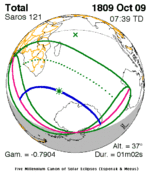 October 9, 1809 (Saros 121) |
 September 7, 1820 (Saros 122) |
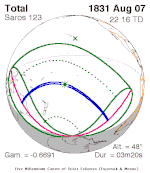 August 7, 1831 (Saros 123) |
 July 8, 1842 (Saros 124) |
 June 6, 1853 (Saros 125) |
 May 6, 1864 (Saros 126) |
 April 6, 1875 (Saros 127) |
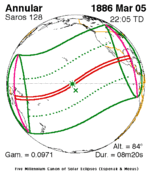 March 5, 1886 (Saros 128) |
 February 1, 1897 (Saros 129) |
 January 3, 1908 (Saros 130) |
 December 3, 1918 (Saros 131) |
 November 1, 1929 (Saros 132) |
 October 1, 1940 (Saros 133) |
 September 1, 1951 (Saros 134) |
 July 31, 1962 (Saros 135) |
 June 30, 1973 (Saros 136) |
 May 30, 1984 (Saros 137) |
 April 29, 1995 (Saros 138) |
 March 29, 2006 (Saros 139) |
 February 26, 2017 (Saros 140) |
 January 26, 2028 (Saros 141) |
 December 26, 2038 (Saros 142) |
 November 25, 2049 (Saros 143) |
 October 24, 2060 (Saros 144) |
 September 23, 2071 (Saros 145) |
 August 24, 2082 (Saros 146) |
 July 23, 2093 (Saros 147) |
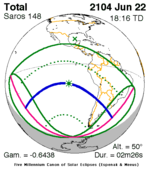 June 22, 2104 (Saros 148) |
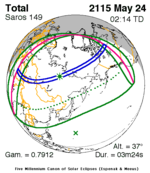 May 24, 2115 (Saros 149) |
 April 22, 2126 (Saros 150) |
 March 21, 2137 (Saros 151) |
 February 19, 2148 (Saros 152) |
 January 19, 2159 (Saros 153) |
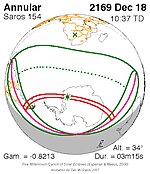 December 18, 2169 (Saros 154) |
 November 17, 2180 (Saros 155) |
 October 18, 2191 (Saros 156) | ||||
The metonic series repeats eclipses every 19 years (6939.69 days), lasting about 5 cycles. Eclipses occur in nearly the same calendar date. In addition, the octon subseries repeats 1/5 of that or every 3.8 years (1387.94 days). All eclipses in this table occur at the Moon's ascending node.
| 22 eclipse events between December 24, 1916 and July 31, 2000 | ||||
|---|---|---|---|---|
| December 24–25 | October 12 | July 31–August 1 | May 19–20 | March 7 |
| 111 | 113 | 115 | 117 | 119 |
 December 24, 1916 |
 July 31, 1924 |
 May 19, 1928 |
 March 7, 1932 | |
| 121 | 123 | 125 | 127 | 129 |
 December 25, 1935 |
 October 12, 1939 |
 August 1, 1943 |
 May 20, 1947 |
 March 7, 1951 |
| 131 | 133 | 135 | 137 | 139 |
 December 25, 1954 |
 October 12, 1958 |
 July 31, 1962 |
 May 20, 1966 |
 March 7, 1970 |
| 141 | 143 | 145 | 147 | 149 |
 December 24, 1973 |
 October 12, 1977 |
 July 31, 1981 |
 May 19, 1985 |
 March 7, 1989 |
| 151 | 153 | 155 | ||
 December 24, 1992 |
 October 12, 1996 |
 July 31, 2000 | ||
- ^ "Solar eclipse of July 31, 1962". NASA. Retrieved March 21, 2017.
- ^ van Gent, R.H. "Solar- and Lunar-Eclipse Predictions from Antiquity to the Present". A Catalogue of Eclipse Cycles. Utrecht University. Retrieved 6 October 2018.
- ^ "NASA - Catalog of Solar Eclipses of Saros 135". eclipse.gsfc.nasa.gov.
- Earth visibility chart and eclipse statistics Eclipse Predictions by Fred Espenak, NASA/ GSFC
| Solar eclipse of July 31, 1962 | |
|---|---|
| Type of eclipse | |
| Nature | Annular |
| Gamma | −0.113 |
| Magnitude | 0.9716 |
| Maximum eclipse | |
| Duration | 213 s (3 min 33 s) |
| Coordinates | 12°00′N 5°42′W / 12°N 5.7°W |
| Max. width of band | 103 km (64 mi) |
| Times ( UTC) | |
| Greatest eclipse | 12:25:33 |
| References | |
| Saros | 135 (36 of 71) |
| Catalog # (SE5000) | 9425 |
An annular solar eclipse occurred at the Moon's ascending node of orbit on Tuesday, July 31, 1962, with a magnitude of 0.9716. A solar eclipse occurs when the Moon passes between Earth and the Sun, thereby totally or partly obscuring the image of the Sun for a viewer on Earth. An annular solar eclipse occurs when the Moon's apparent diameter is smaller than the Sun's, blocking most of the Sun's light and causing the Sun to look like an annulus (ring). An annular eclipse appears as a partial eclipse over a region of the Earth thousands of kilometres wide. Occurring only 4.7 days before apogee (on August 5, 1962), the Moon's apparent diameter was larger. This solar eclipse occurred 44 days after the final game of 1962 FIFA World Cup.
Places inside the annular eclipse included Venezuela, northern Roraima in Brazil, Guyana, Dutch Guiana (today's Suriname) including the capital city Paramaribo, Senegal, Gambia Colony and Protectorate (today's Gambia) including the southern part of the capital city Banjul, Mali including the capital city Bamako, Upper Volta (today's Burkina Faso), Ghana, Togo, Dahomey (today's Benin), Nigeria, Cameroon including the capital city Yaoundé, Congo-Brazzaville, Congo-Léopoldville (today's DR Congo), Tanganyika (now belonging to Tanzania), northeastern tip of Portuguese Mozambique (today's Mozambique), French Comoros (today's Comoros), Mayotte, and the Malagasy Republic (today's Madagascar). The greatest eclipse was in the area of Kouoro, Mali at 12 N, 5.7 W at 12:25 (UTC) and lasted for 3 minutes. [1]
- A total solar eclipse on February 5, 1962.
- A penumbral lunar eclipse on February 19, 1962.
- A penumbral lunar eclipse on July 17, 1962.
- An annular solar eclipse on July 31, 1962.
- A penumbral lunar eclipse on August 15, 1962.
- Preceded by: Solar eclipse of October 12, 1958
- Followed by: Solar eclipse of May 20, 1966
- Preceded by: Solar eclipse of June 20, 1955
- Followed by: Solar eclipse of September 11, 1969
- Preceded by: Lunar eclipse of July 26, 1953
- Followed by: Lunar eclipse of August 6, 1971
- Preceded by: Solar eclipse of September 1, 1951
- Followed by: Solar eclipse of June 30, 1973
- Preceded by: Solar eclipse of July 20, 1944
- Followed by: Solar eclipse of August 10, 1980
- Preceded by: Solar eclipse of August 21, 1933
- Followed by: Solar eclipse of July 11, 1991
- Preceded by: Solar eclipse of September 29, 1875
- Followed by: Solar eclipse of May 31, 2049
This eclipse is a member of a semester series. An eclipse in a semester series of solar eclipses repeats approximately every 177 days and 4 hours (a semester) at alternating nodes of the Moon's orbit. [2]
The partial solar eclipses on June 10, 1964 and December 4, 1964 occur in the next lunar year eclipse set.
| Solar eclipse series sets from 1961 to 1964 | ||||||
|---|---|---|---|---|---|---|
| Descending node | Ascending node | |||||
| Saros | Map | Gamma | Saros | Map | Gamma | |
120
|
February 15, 1961 Total |
0.883 | 125 |
August 11, 1961 Annular |
−0.8859 | |
| 130 |
February 5, 1962 Total |
0.2107 | 135 |
July 31, 1962 Annular |
−0.113 | |
| 140 |
January 25, 1963 Annular |
−0.4898 | 145 |
July 20, 1963 Total |
0.6571 | |
| 150 |
January 14, 1964 Partial |
−1.2354 | 155 |
July 9, 1964 Partial |
1.3623 | |
This eclipse is a part of Saros series 135, repeating every 18 years, 11 days, and containing 71 events. The series started with a partial solar eclipse on July 5, 1331. It contains annular eclipses from October 21, 1511 through February 24, 2305; hybrid eclipses on March 8, 2323 and March 18, 2341; and total eclipses from March 29, 2359 through May 22, 2449. The series ends at member 71 as a partial eclipse on August 17, 2593. Its eclipses are tabulated in three columns; every third eclipse in the same column is one exeligmos apart, so they all cast shadows over approximately the same parts of the Earth.
The longest duration of annularity was produced by member 16 at 10 minutes, 41 seconds on December 24, 1601, and the longest duration of totality will be produced by member 62 at 2 minutes, 27 seconds on May 12, 2431. All eclipses in this series occur at the Moon’s ascending node of orbit. [3]
| Series members 28–49 occur between 1801 and 2200: | ||
|---|---|---|
| 28 | 29 | 30 |
 May 5, 1818 |
 May 15, 1836 |
 May 26, 1854 |
| 31 | 32 | 33 |
 June 6, 1872 |
 June 17, 1890 |
 June 28, 1908 |
| 34 | 35 | 36 |
 July 9, 1926 |
 July 20, 1944 |
 July 31, 1962 |
| 37 | 38 | 39 |
 August 10, 1980 |
 August 22, 1998 |
 September 1, 2016 |
| 40 | 42 | 42 |
 September 12, 2034 |
 September 22, 2052 |
 October 4, 2070 |
| 43 | 44 | 45 |
 October 14, 2088 |
 October 26, 2106 |
 November 6, 2124 |
| 46 | 47 | 48 |
 November 17, 2142 |
 November 27, 2160 |
 December 9, 2178 |
| 49 | ||
 December 19, 2196 | ||
This eclipse is a part of the long period inex cycle, repeating at alternating nodes, every 358 synodic months (≈ 10,571.95 days, or 29 years minus 20 days). Their appearance and longitude are irregular due to a lack of synchronization with the anomalistic month (period of perigee). However, groupings of 3 inex cycles (≈ 87 years minus 2 months) comes close (≈ 1,151.02 anomalistic months), so eclipses are similar in these groupings. In the 18th century:
- Solar Saros 127: Total Solar Eclipse of 1731 Jan 08
- Solar Saros 128: Annular Solar Eclipse of 1759 Dec 19
- Solar Saros 129: Annular Solar Eclipse of 1788 Nov 27
| Inex series members between 1801 and 2200: | ||
|---|---|---|
| Near lunar perigee | After lunar apogee Before lunar perigee |
Before lunar apogee After lunar perigee |
 November 9, 1817 (Saros 130) |
 October 20, 1846 (Saros 131) |
 September 29, 1875 (Saros 132) |
 September 9, 1904 (Saros 133) |
 August 21, 1933 (Saros 134) |
 July 31, 1962 (Saros 135) |
 July 11, 1991 (Saros 136) |
 June 21, 2020 (Saros 137) |
 May 31, 2049 (Saros 138) |
 May 11, 2078 (Saros 139) |
 April 23, 2107 (Saros 140) |
 April 1, 2136 (Saros 141) |
 March 12, 2165 (Saros 142) |
 February 21, 2194 (Saros 143) |
|
In the 23rd century:
- Solar Saros 144: Annular Solar Eclipse of 2223 Feb 01
- Solar Saros 145: Total Solar Eclipse of 2252 Jan 12
- Solar Saros 146: Annular Solar Eclipse of 2280 Dec 22
This eclipse is a part of a tritos cycle, repeating at alternating nodes every 135 synodic months (≈ 3986.63 days, or 11 years minus 1 month). Their appearance and longitude are irregular due to a lack of synchronization with the anomalistic month (period of perigee), but groupings of 3 tritos cycles (≈ 33 years minus 3 months) come close (≈ 434.044 anomalistic months), so eclipses are similar in these groupings.
| Series members between 1801 and 2200 | ||||
|---|---|---|---|---|
 October 9, 1809 (Saros 121) |
 September 7, 1820 (Saros 122) |
 August 7, 1831 (Saros 123) |
 July 8, 1842 (Saros 124) |
 June 6, 1853 (Saros 125) |
 May 6, 1864 (Saros 126) |
 April 6, 1875 (Saros 127) |
 March 5, 1886 (Saros 128) |
 February 1, 1897 (Saros 129) |
 January 3, 1908 (Saros 130) |
 December 3, 1918 (Saros 131) |
 November 1, 1929 (Saros 132) |
 October 1, 1940 (Saros 133) |
 September 1, 1951 (Saros 134) |
 July 31, 1962 (Saros 135) |
 June 30, 1973 (Saros 136) |
 May 30, 1984 (Saros 137) |
 April 29, 1995 (Saros 138) |
 March 29, 2006 (Saros 139) |
 February 26, 2017 (Saros 140) |
 January 26, 2028 (Saros 141) |
 December 26, 2038 (Saros 142) |
 November 25, 2049 (Saros 143) |
 October 24, 2060 (Saros 144) |
 September 23, 2071 (Saros 145) |
 August 24, 2082 (Saros 146) |
 July 23, 2093 (Saros 147) |
 June 22, 2104 (Saros 148) |
 May 24, 2115 (Saros 149) |
 April 22, 2126 (Saros 150) |
 March 21, 2137 (Saros 151) |
 February 19, 2148 (Saros 152) |
 January 19, 2159 (Saros 153) |
 December 18, 2169 (Saros 154) |
 November 17, 2180 (Saros 155) |
 October 18, 2191 (Saros 156) | ||||
The metonic series repeats eclipses every 19 years (6939.69 days), lasting about 5 cycles. Eclipses occur in nearly the same calendar date. In addition, the octon subseries repeats 1/5 of that or every 3.8 years (1387.94 days). All eclipses in this table occur at the Moon's ascending node.
| 22 eclipse events between December 24, 1916 and July 31, 2000 | ||||
|---|---|---|---|---|
| December 24–25 | October 12 | July 31–August 1 | May 19–20 | March 7 |
| 111 | 113 | 115 | 117 | 119 |
 December 24, 1916 |
 July 31, 1924 |
 May 19, 1928 |
 March 7, 1932 | |
| 121 | 123 | 125 | 127 | 129 |
 December 25, 1935 |
 October 12, 1939 |
 August 1, 1943 |
 May 20, 1947 |
 March 7, 1951 |
| 131 | 133 | 135 | 137 | 139 |
 December 25, 1954 |
 October 12, 1958 |
 July 31, 1962 |
 May 20, 1966 |
 March 7, 1970 |
| 141 | 143 | 145 | 147 | 149 |
 December 24, 1973 |
 October 12, 1977 |
 July 31, 1981 |
 May 19, 1985 |
 March 7, 1989 |
| 151 | 153 | 155 | ||
 December 24, 1992 |
 October 12, 1996 |
 July 31, 2000 | ||
- ^ "Solar eclipse of July 31, 1962". NASA. Retrieved March 21, 2017.
- ^ van Gent, R.H. "Solar- and Lunar-Eclipse Predictions from Antiquity to the Present". A Catalogue of Eclipse Cycles. Utrecht University. Retrieved 6 October 2018.
- ^ "NASA - Catalog of Solar Eclipses of Saros 135". eclipse.gsfc.nasa.gov.
- Earth visibility chart and eclipse statistics Eclipse Predictions by Fred Espenak, NASA/ GSFC
